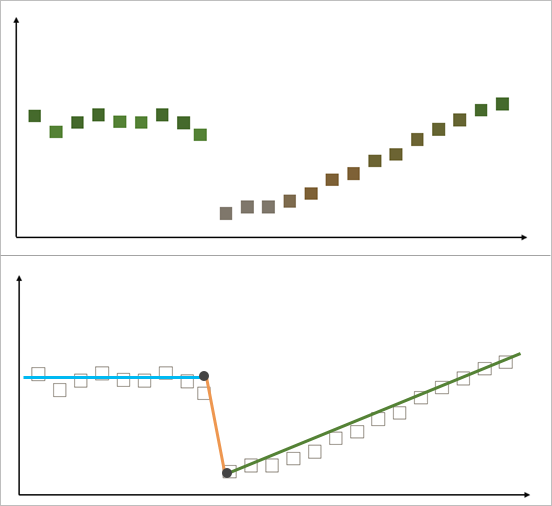Available with Image Analyst license.
The Analyze Changes Using LandTrendr tool, in conjunction with the Detect Change Using Change Analysis Raster tool, can be used to identify changes in pixel values over time to indicate land use or land cover changes.
LandTrendr algorithm
The Analyze Changes Using LandTrendr tool uses the Landsat-based detection of trends in disturbance and recovery (LandTrendr) algorithm (Kennedy et al, 2010). The purpose of this algorithm is to extract information about how a feature in a landscape has changed due to disturbance (a short period of change from one state to another) and recovery (the longer process of returning to the original state).
Change detection
The LandTrendr algorithm is founded on the idea that a pixel's history can be broken down into several linear segments over time. There may be long periods with very little change, represented by a straight line with little slope. When disturbance occurs, the pixel's value will experience a change, represented by a short, possibly steeply sloped line segment. If recovery is allowed to occur, for example, after a forest fire, this will be represented by a long, gently sloping line, moving back toward the pixel's original value.

In the graph above, a pixel was green for some time, then a disturbance occurred and the pixel changed to a gray-brown color, then slowly shifted back to green over time. In the LandTrendr algorithm, this is represented by three linear segments shown in the graph at the bottom of the image. There are vertices at each change that help describe the segments.
This example is a highly simplified history for a pixel over time. There may be many changes to a landscape over the years, large and small. The Analyze Changes Using LandTrendr tool provides parameters to control the model information that is extracted, so that you only retrieve the changes you are interested in.
Input image requirements
The LandTrendr algorithm was designed for Landsat TM, Landsat ETM+, and Landsat OLI data Surface Reflectance data. However, the Analyze Changes Using LandTrendr tool will detect change for imagery from any supported sensor, as well as imagery derivatives such as band indexes.
The algorithm requires only one image for each year in your analysis, and it is recommended that you have at least six years of data for this tool. Generate a multidimensional mosaic dataset or multidimensional raster dataset in Cloud Raster Format (.crf) with yearly imagery and use this as input to the tool.
Segmentation is performed on only one band in the image. Therefore, it is important to choose the band for processing that will best represent the information you want to extract. For example, the near-infrared (NIR) band might be the best band to use to capture changes in vegetation. However, in many cases, a band index might be better suited to extract information. For example, to visualize changes in open water features in a landscape, you may want to use the Modified Normalized Difference Water Index (MNDWI), which uses spectral information in the green and SWIR bands.
Because this algorithm depends on the ability to observe a phenomenon consistently over time, it is important to have imagery that has been normalized for atmospheric and sensor noise, clouds, and cloud shadow. If you have multiple images from a single year (and preferably from a single season to minimize seasonal fluctuations), you can remove cloud and cloud shadow from several images and combine them to generate one representative image for that year.
Model results
The output from the Analyze Changes Using LandTrendr tool is a change analysis raster containing the model coefficients. There is one slice for each year in the analysis, so each pixel contains a different group of model coefficients for each year. Included in the output is a band called FittedValue, which provides the pixel value when it is fitted to the modeled line segment at that point in time.
Model coefficients are difficult to interpret visually. There are additional tools to use to interpret the data:
- Create a temporal profile chart to explore pixel changes over time, using the Fitted Value band. This will show you the linear segments extracted for a pixel using the LandTrendr algorithm.
- Use the change analysis raster as the input to the Detect Change Using Change Analysis Raster tool to extract date of change information.
Temporal profile chart
To explore the segmented results of the model, generate a temporal profile chart for the change analysis output from the Analyze Changes Using LandTrendr tool, using the Fitted Value band.
Date of change
To extract information about the dates at which pixel values changed, use the Detect Change Using Change Analysis Raster tool. This tool generates a raster in which each pixel has a date value corresponding to the date you are interested in. You can extract the beginning date or end date of a particular segment in the model. For example, you can extract the beginning date of the segment that represents the longest period of change, represented by point  in the chart above, or you can extract the end date of the segment that represents the fastest change (highest slope value), represented by point
in the chart above, or you can extract the end date of the segment that represents the fastest change (highest slope value), represented by point  in the chart above.
in the chart above.